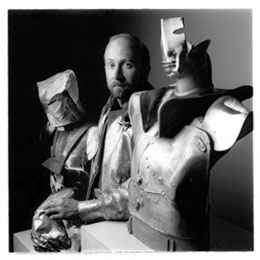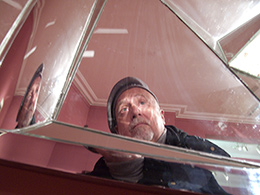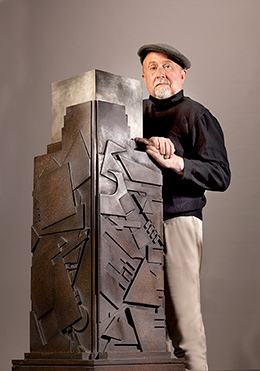|
|
|
|
|
|
|
|
|
|
|
|
||||||||
|
Bay Area artist ROGER ARVID ANDERSON is a native of Minnesota. He was born in St. Paul in 1946 and raised in the historic village of Little Canada. His Scandinavian heritage gave him a predisposition for craftsmanship and design. His father was an avid nature photographer. He gave him his first cameras, and by example taught him the elements of composition. The artist attended Dartmouth College in Hanover, New Hampshire and graduated with a BA in 1968. He studied creative writing under Pulitzer Prize winning poet Richard Eberhart. He won a poetry award and was also awarded a Dartmouth Fellowship to Cambridge. At Cambridge University in England the artist was a member of St. John’s College where he won the Master’s Prize for a sequence of poems. He studied Modern European history under Sir Harry Hinsley, wartime adviser to Churchill. During holiday breaks and for two summers, 1969 and 1970, the artist traveled extensively in Europe and kept a serious photographic record in both color and B/W. The artist moved to San Francisco in 1972. He worked for the National Film Board of Canada as its west coast distribution agent for its documentary, animation and travel films. His interest in screen writing dates from this period. The NFB Office was closed in 1979. During the 1970’s the artist was active writing poetry, drawing portraits and painting watercolors. In 1972 he did a backstage photographic essay at the Palace Theater of the flamboyant performance group The Cockettes. In 1981 Roger Arvid Anderson became self-employed as an artist and fine art consultant. As a consultant he specialized in sculpture and the decorative arts. He helped build private collections and installed a private museum of Art Nouveau in Tokyo. He remains active within museum and collecting circles. His personal collection of Japanese and Korean metalwork is now with the Minneapolis Institute of Arts. His personal collection of 8 giant bronze vessels by his friend Peter Voulkos is now on permanent display at the Baker/Berry Library at Dartmouth College. During the 1980’s the artist became increasingly active as a sculptor. He learned the principles of investment casting and metal-finishing at Nordhammer Art Foundry in Oakland. In 1986 he began casting with ceramic shell at Artworks Foundry in Berkeley. At this time he completed his first body of mature work as a sculptor. (see IMAGINARY DIGS, INNER SANCTUM and METAPHYSICAL LANDSCAPES galleries) In 1990 the Minnesota Museum of Art in St. Paul featured his work along with the work of Paul Manship and Donald DeLue in a show titled, “Mythic Sculpture.” The artist narrated a half-hour film based on the show. The museum also purchased the horsehead, BUCEPHALUS. From 1989 to 1995 the artist kept a giant studio at 2200 Adeline in Oakland. At that time the artist worked primarily in wood with the intention of casting or fabricating the architectonic models in bronze. (see TEMPLES AND TOWERS, RETABLOS, and THREE MAGI galleries) The Loma Prieta earthquake of October 1989 destroyed most of the artwork in wood in the artist’s studio. His photographic record of that destruction and the spontaneous geometry it engendered inspired the artist to start photographing again. He studied darkroom technique and used that opportunity to create a set of elaborate photograms. He also began intensive shooting using both 35mm and medium format cameras. His photo essays include: The Age of Bronze, Shadow-Boxing, Street Smart, Bravado, The Square Circled, Urban Zen, Window-Shopping, Yellow Brick Road, and Folsom. From September of 2001 to November of 2002 the artist spent over a year photographing STAR-SPANGLED: picturing America after 9/11, from Cape Cod to the Santa Monica Pier. In 2005 his 1972 backstage shoot of the Cockettes was digitally restored and embellished by the artist for a portfolio of prints called Stage Struck. In October of 2010 the artist spent a month in Berlin focusing his camera on the stones and shadows of that haunted city, leading to two suites of images called Denkmal and Tempelhof. (see PHOTO ESSAYS). In 2003 the artist began a major new body of sculptural work that he calls geological cubism. Tabula Rasa, Sculpture 2003 – 2007 is the first catalog of that work. In 2008 he was the featured artist at New Concept Gallery in Santa Fe. The month in Santa Fe lead to his first essays with digital cameras including Underfoot, taken in Monument Valley. (see TRAIL MARKERS, CONSTELLATIONS and THREE HAIKU MASTERS galleries) In 2008 the department of Special Collections and Rare Books at the Andersen Library of the University of Minnesota became the archive and primary repository of the artist’s manuscripts, photographs, drawings and personal papers. In 2010 the artist cast two large bronzes. Emergence: The First People was installed that May on Canyon Road as a tribute to the 400th anniversary of the founding of Santa Fe. The subject matter was inspired by a reading of Native American creation stories and portrays two elemental figures emerging from the primal mud. The second bronze, Homage to the Cube was cast over the summer. It is a nearly four foot prototype for a monument meant to be fabricated at 18 feet in corten and stainless steel. The design has evolved over 22 years. It was first started in 1988 as an entry archway and then substantially revised in 1999 as a millennial celebration of the cube as the building block of civilization. The four panels of the column supporting the cube each feature one of the primary forms of the geometric canon: the circle, the square, the triangle and the cross. The Frost Frost Museum at Florida International University in Miami will be showing-casing the finished sculpture during the winter of 2010/2011. From EXCAVATIONS: AN ARTIST’S STATEMENT by Roger Arvid Anderson “…Sometimes I think my bronze pieces are excavated from my imagination. Within myself I feel I’ve discovered an entire civilization rooted in that theater that deposits its stage between reality and fantasy. I’m possessed by a passion to dig and search. I also consider the imaginary civilization I explore to be on a conversational continuum that unites the past, present and future. I may share Caesar’s expansive taste, however, unlike the ancient Romans, I’m not confined to the Mediterranean basin for ideological plunder, nor for that matter is my mind confined to one planet or solar system. Space Age technology and science fiction inspire me as much as a Shang Dynasty bronze vessel or an African tribal mask…”
|
|
|
||||||

 Cubist Self-Portrait, Berlin 2010
Cubist Self-Portrait, Berlin 2010